
- Homepage
- Brand
- Anchor Hocking (106)
- Antique (27)
- Atterbury (26)
- Corningware (23)
- Federal Glass (38)
- Fenton (659)
- Fire King (151)
- Fireking (62)
- Fostoria (26)
- Hazel-atlas (72)
- Indiana Glass (35)
- Mckee (76)
- Miriam Haskell (43)
- Pyrex (771)
- Unknown (31)
- Unmarked (108)
- Vallerysthal (41)
- Vintage (24)
- Westmoreland (220)
- Westmoreland Glass (19)
- ... (3245)
- Material
- Brass (76)
- Brass, Milk Glass (9)
- Cast Iron (4)
- Ceramic (14)
- Chrome (15)
- Glass (2422)
- Glass & Brass (6)
- Glass And Metal (7)
- Glass Milkglass (24)
- Glass, Metal (32)
- Glass, Milk Glass (34)
- Glass, Rhinestone (7)
- Metal (14)
- Metal Fitter Cap (3)
- Metal, Glass (5)
- Milk Glass (253)
- Milk Glass, Glass (18)
- Milkglass (7)
- Porcelain (16)
- Rhinestone (8)
- ... (2829)
- Pattern
- Amish Butterprint (69)
- Blue Cornflower (21)
- Butterprint (27)
- Emerald Crest (16)
- English Hobnail (15)
- Floral (51)
- Flower (15)
- Gooseberry (36)
- Harvest (23)
- Hobnail (219)
- Paneled Grape (32)
- Poppy (36)
- Roses (16)
- Ruffled (16)
- Silver Crest (66)
- Snowflake (18)
- Solid (24)
- Spring Blossom (34)
- Swirl (43)
- Vintage (410)
- ... (4616)
- Set Includes
- 1 Bowl / Vessel (8)
- 4 Bowls (5)
- Bowl (159)
- Bowl Set (344)
- Bowl Set, Complete (8)
- Bowl, Bowl Set (10)
- Bowl, Cup (15)
- Bowl, Glass, Tray (6)
- Bowl, Lid (6)
- Bracelet, Earrings (11)
- Butter Dish (4)
- Complete (27)
- Compote Bowl (4)
- Cup (23)
- Cup & Saucer Set (6)
- Fruit Bowl (5)
- Lid (7)
- Mug (7)
- Plate (11)
- Serving Bowl (6)
- ... (5131)
- Shape
- Vintage
6 Tiffin-Franciscan Milk Opaque Glass Punch Cups Moon & Star Patterned RARE

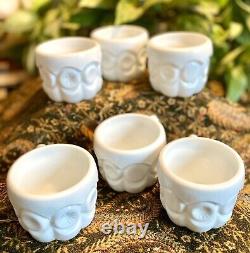
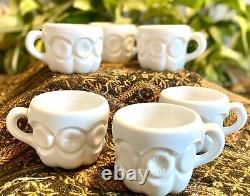
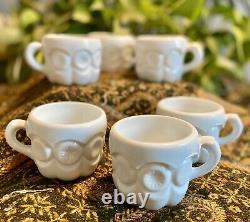
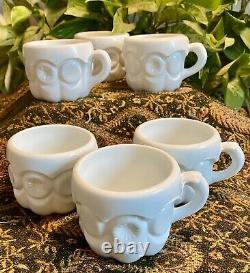
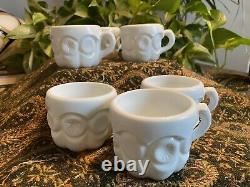
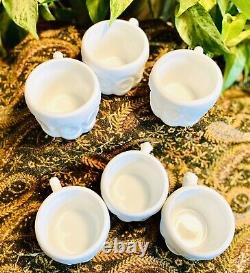
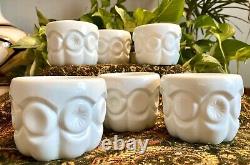
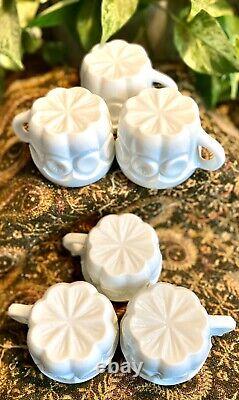
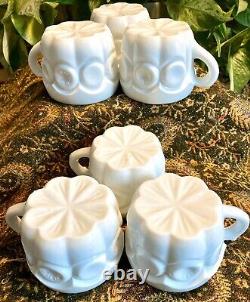
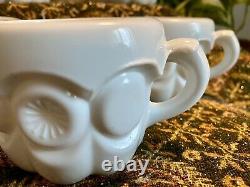
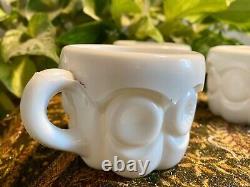
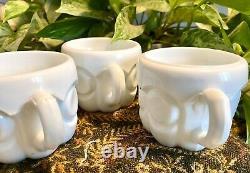
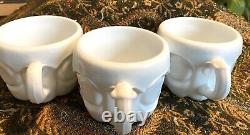
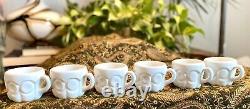
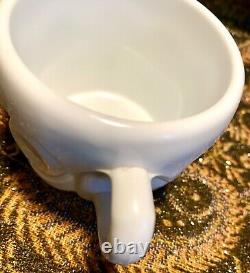
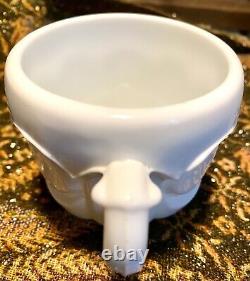
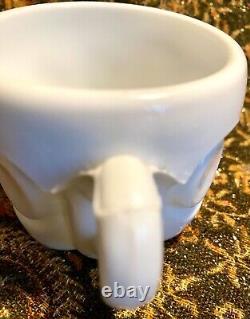
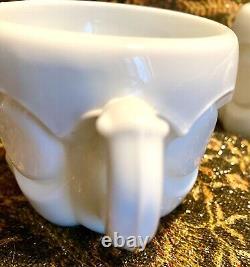
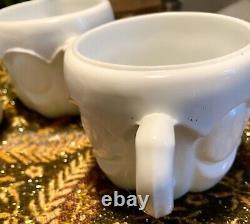
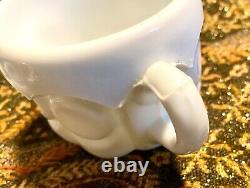
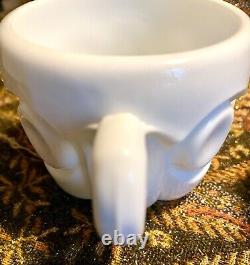


Thisis one of two styles of punch cups that Tiffin-Franciscan put out for theirMoon & Star line. These have a modern design, really cool and heavy duty. Each opaque patterned cup is encircled with impressions of starbursts around the the entire cup. The base of each glass has a slightly dipped and raised 8-point star, sunburst, flower-like pattern. It is extremely rare to find this Moon & Sun pattern by Tiffin Franciscan in the white opaque/milk pressed glass.
The majority of this patterned punch bowl set were created from CLEAR pressed glass. Some of the Moon & Star production line sets had pops of color added to this pattern as well.
There are several mistakes in the cups wherethe handle begins. Please see pictures, I have tried to take them so this distinction can be seen on each cup. This would make this set even rarer than your typical set of milk glass punch cups. All six punch cups are in excellent vintage/used condition with no chipsor cracks or visible wear.
My feedback is very important to me. And I strive for 100% satisfaction. A little history on Milk Glass and Tiffan Franciscan. The origins of milk glass begin inVenice in the 16th Century when it was then known as "opal" glass. Milk glass is also known as vitro-porcelain glass, a term first used by Sowerbyfor their range of pressed milk glass, as the opaque glass looks likeporcelain.InJuly 1888, it was announced that the A. Beatty & Sons glass factory ofSteubenville, Ohio, would be relocating to Tiffin, Ohio.
Beatty had beennegotiating with various communities for more than a year to establish a sitefor the new factory. Construction of a three-furnaceglass factory at the corner of Fourth Avenue and Vine Street began in September1888, and operations commenced on August 15, 1889.
Early production capacitywas reported to be 500,000 pressed tumblers per week. Beatty & Sons merged with the United States Glass Company on January 1,1892, and became one of nineteen factories of the large corporation. The Tiffinfactory was designated Factory R. On May 23, 1893, less than two years later, Factory R was destroyed by fire. The factory was rebuilt in Tiffin in returnfor two additional years of free natural gas. In1958, serious financial difficulties arose within the corporation, resulting inthe sale of the assets to a New York investment firm. Business conditions didnot improve and a second sale took place in March 1961 to Brilhart PlasticsCorporation of Mineola, New York.In 1962, bankruptcy occurred; however, theTiffin factory remained open until early 1963. In that year, four formeremployees - Paul Williams, C. Ellsworth Beebe, and Bea Platt -bought the plant and renamed it the Tiffin Art Glass Company. Incorporationtook place on May 1, 1963.
The start-up date for the new Tiffin venture wasSeptember 16, 1963. A great loss was incurred on August 3, 1963, when the Glassportfactory was destroyed by a tornado.
The company was renamed the Tiffin Glass Company, Inc. During theseyears, stemware remained the major focus of production, with blown and pressedware also manufactured.
It continued to be known as the Tiffin Glass Company;but, in addition to using the gold Tiffin shield sticker, Interpace began touse a paper label, "Franciscan Crystal, " which they placed on selected stemwarelines in May 1969. This practice continued for two years. Interpace introducedseveral new stemware lines to coordinate with their china dinnerware patterns:Jubilation, Canterbury II, Flambeau, Revelation, Madeira, and Cabaret.TheTiffin factory furnished a variety of stemware patterns to numerous companiesfor private distribution. As early as 1930, Tiffin provided tableware to theSears and Roebuck, and Montgomery-Ward companies, and they continued to providestemware to various retail outlets through the 1970s. Among these companieswere Tiffany's, Macy's, Colony House, Royal Medallion, Nancy Prentiss, AmericanManor, and Reynolds Crystal. American Manor and Reynolds Crystal weresubsidiaries of Interpace Corp.
During this ten-year period, stemware in several new colors was introduced tocoordinate with Interpace's Shenango China. The furnaces wereshut down on May 1, 1980, the date considered by collectors to be the end ofthe Tiffin Glass Company.
The Outlet Store and a decorating shop remained openuntil October 1984, when the facility permanently closed. The city offered the property free to any company that would bring100 jobs into the city. Unable to find a tenant, the city demolished part ofthe factory in late December 1985, and January 1986. Afterproduction had ceased in 1980, the molds were dispersed and Russell Voglesongof Summit Art Glass Company of Ravenna, Ohio, acquired the Tiffin shieldtrademark mold.
To date, the logo has been reproduced in five colors: pink, cobalt blue, red, plum, green and yellow (vaseline), some with satin oriridized finishes. Overthe years, Tiffin Glass products were identified by means of various paperlabels; this mark was used intermittently through the 1970s.

